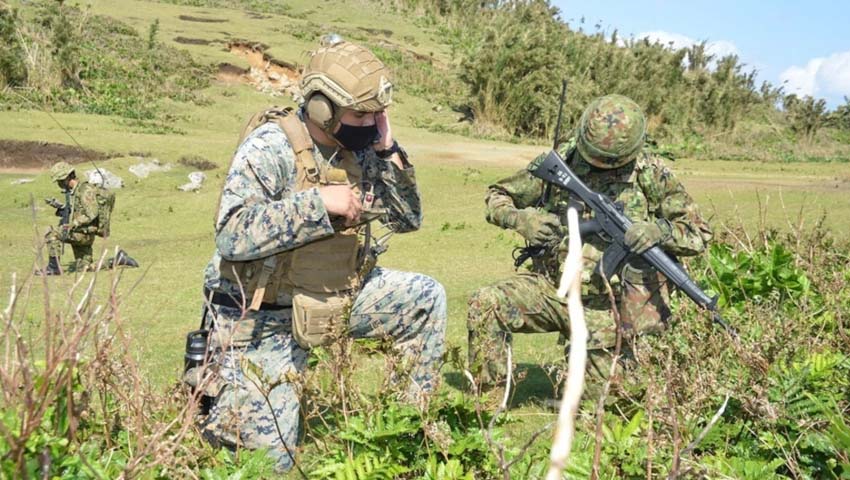In the early hours of the morning, Japanese and American Marines onboard Japanese CH-47JA Chinooks touched down and delivered streams of Amphibious Rapid Deployment Brigade troops while US Marines hit the beach via small boats briskly navigating over the horizon from the USS Ashland to Gaja-Jima.
As the joint force disappeared in fast-moving columns into the foliage of the small uninhabited island off the coast of Japan, their counterparts to the south are already preparing missile launchers and co-ordinating fire support against enemy targets on land and sea.
These scenes and more dotted the islands and waters off the coast of Japan for the past two weeks, as US Marines and the JSDF conducted Keen Sword 21, a bilateral exercise with a series of wide-ranging missions focused on strengthening the interoperability of forces forged through the 60-year-old alliance.
ARDB members took point alongside Marines with 1st Battalion, 3rd Marine Regiment arriving from the air and sea in a bilateral amphibious assault on Gaja-Jima featuring troops from both forces landing simultaneously on the remote island and demonstrating the ability to eliminate an occupying enemy.
Major Dennis Graziosi, 1st Battalion, 2nd Marines' operations officer, said, “Integrating these operations with joint and bilateral command and control nodes at other location on Okinawa increases our interoperability with allies and bolsters our ability to fight together.”
This mission showcased a combined ability to seize territory threatened by an adversary, defend key maritime terrain, and establish expeditionary advanced bases for follow-on operations through swift, integrated, and lethal action.
More than 320 kilometres to the south, a complex but effective integrated joint targeting and fire support co-ordination effort maintained a blistering pace, with elements of the US Army’s 17th Field Artillery Brigade joining 12th Marine Regiment and 3rd Marine Division in mobile command-and-control nodes on Camp Hansen and Camp Courtney in Okinawa.
Employing deliberate and dynamic targeting against land, sea, and air targets, these Marines and Soldiers further enabled the bilateral amphibious force to maneuver through the littorals while supporting naval operations at sea.
One such precision, long-range fires capability was on display as High Mobility Artillery Rockets System launchers, from both the Marine Corps and Army, landed on beaches via ocean-going transports in support of an amphibious raid elsewhere in the exercise area. HIMARS launchers can be moved throughout a distributed maritime environment via air, sea, or land.
This freedom of movement, coupled with the long-range strike capability of HIMARS, means that the US-Japan team can rapidly move precision-fire weapons into position and strike distant targets smoothly.
Meanwhile, Marines from the 5th Air-Naval Gunfire Liaison Company integrated into the ARDB and embarked on a Japan Maritime Self-Defense Force ship to enhance combined command and control capabilities to further enable bilateral amphibious operations.
Major Bradley Ebach, air officer with 5th ANGLICO explained, “Our Marines assisted in mission coordination between the JSDF Amphibious Task Force and USS Ashland with 1st Battalion, 3rd Marines embarked. During the execution of the bilateral amphibious exercise, we employed a Joint Terminal Attack Controller to assist with close air support and provided liaisons to the ARDB Fire Support Coordination Center during the assault.”
While US and Japan naval and expeditionary forces continued operations at sea and establishing advanced bases, Marines with 1st Battalion, 2nd Marines and 1st Battalion, 3rd Marines conducted a grueling force-on-force exercise stretching across the challenging terrain of the jungles in northern Okinawa.
As the Marines battled through the heat and humidity and thick vegetation in the hilly jungles, members of 1st Battalion, 2nd Marines and the JSDF’s 15th Brigade exercised command and control through combined operations centres located on Camp Foster and Marine Corps Air Station Futenma.
Maj Graziosi, who brings combat experience from Afghanistan to his current assignment as operations officer for 1st Battalion, 2nd Marines, “This force-on-force evolution in a jungle environment provided a realistic training opportunity focused on defeating a peer adversary in any climb and place.
“Integrating these operations with joint and bilateral command and control nodes at other location on Okinawa increases our interoperability with allies and bolsters our ability to fight together.”
Keen Sword 21, the latest in a series of regularly-held exercises between Japan and the US, represents continuing advancements among the longtime allies in combined operations across an increasingly distributed and complex environment.
Through this exercise, the shape of future operations in the region is on display – fast, fluid, and together with allies and partners.



